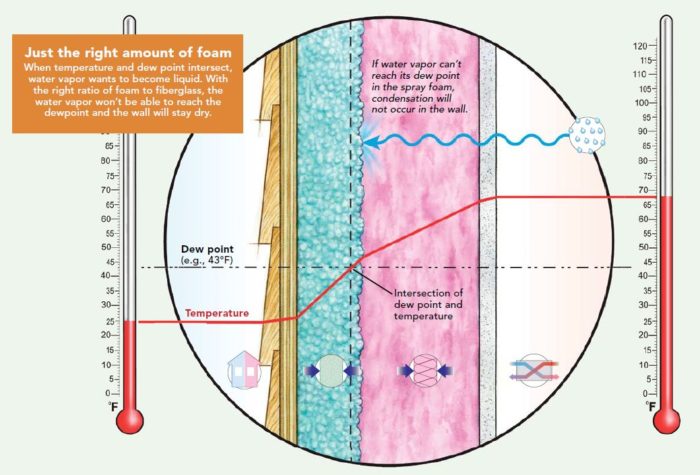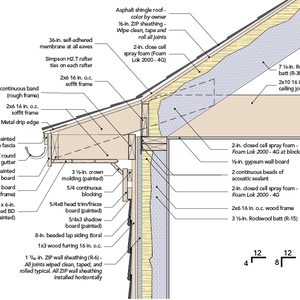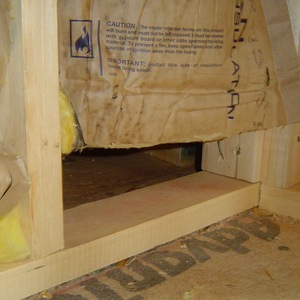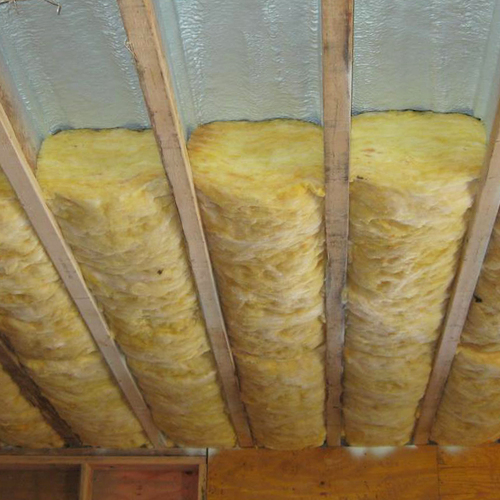
Image Credit: Fine Homebuilding
One thing I’ve noticed over the years is that construction methods don’t change quickly — and when they do change, the change is apt to be along the lines of current practices. That makes sense. It’d be near impossible to run a business if you were changing your technique and product five times a week.
Flash and batt insulation is one example of a new technique being implemented by insulation contractors. Flash and batt is a hybrid insulation approach combining fiberglass insulation and closed-cell spray foam.
Fiberglass devoured the insulation industry in the 1970s, for obvious reasons. It is cheap, simple to install (if not easy to install well), and readily available. Any weekend warrior with a stapler and utility knife can install the stuff. Sure, there’s all kinds of compromising gaps and holes but, hey — it’s easy!
However, fiberglass’s shortcomings are just as well known. Fiberglass isn’t an air barrier or vapor barrier, it performs poorly in very cold climates, and it is less green than cellulose.
For these reasons, fiberglass has been paired with spray foam to improve its performance without fundamentally changing the construction process. By using the flash-and-batt method, any contractor building a standard wall frame can improve the wall’s thermal performance and airtightness without fundamentally altering the project.
What is flash and batt?
Flash and batt insulation is a method of insulating standard stud walls by augmenting fiberglass batts with 2 inches of closed-cell spray foam applied to the interior of the building sheathing. The standard framing includes 2×6 vertical studs spaced 16 inches on center, drywall interior finish, OSB or plywood exterior sheathing, Tyvek or a comparable water-resistant barrier (WRB), and siding.
The cavity insulation normally consists of 6-inch fiberglass batts. In a flash-and-batt installation, part of the fiberglass is replaced with closed-cell spray foam and the remainder is either fiberglass or (occasionally) cellulose. The depth of the spray foam depends on the climate zone, with colder zones requiring thicker foam to keep the wall cavity above the dew point during the winter.
If the stud bays are insulated with cellulose or loose fiberglass, the system is sometimes called “flash and fill” — an expression that still sounds oddly illicit.
This system creates an assembly with a slightly higher R-value than insulating with batts alone, but it doesn’t fundamentally change the wall framing. It’s not (for example) a SIP (structural insulated panel) wall, which would be an entirely different building concept.
Advantages of flash and batt
R-Value: While it isn’t a radical improvement over standard walls, flash and batt systems do have a higher R-value. Replacing 2 inches of fiberglass (at around R-3.5 per inch) with 2 inches of closed-cell spray foam (with an aged R-value of around R-6 per inch) will improve the wall’s thermal resistance. And who doesn’t want that?
Ease of installation: Of all your higher performing wall systems, the flash-and-batt system is by far the easiest for most contractors to install. All of the framing elements are standard; the only change is the call to a spray foam subcontractor. While other systems like SIPs or advanced framing usually require an experienced crew, a flash-and-batt project can be installed by any contractor.
Air leakage: The addition of a layer of spray foam makes these building assemblies much tighter than standard framing. Normal fiberglass and cellulose are air-permeable (even dense-packed cellulose and wet-sprayed cellulose aren’t quite airtight) and must be paired with an air barrier. The 2 inches of spray foam acts as an air barrier, stopping air movement through the exterior sheathing.
Moisture: Flash-and-batt systems present something of a mixed bag when it comes to moisture control. The 2 inches of spray foam will help maintain a higher temperature in the wall assembly, keeping surfaces above the dew point during the winter. However, some overzealous builders install a polyethylene (plastic) vapor barrier on the interior. If the wall has a vapor retardant layer on both sides, it has limited drying potential. If the assembly were to ever get wet, the moisture would likely remain for an extended period.
Disadvantages of flash and batt
Thermal bridging: One of the big knocks on flash and batt is that it doesn’t address thermal bridging. The spray foam provides a little more R-value than fiberglass, but the heat flowing through the uninsulated wood studs still compromises the wall assembly’s overall R-value. Like standard insulation and framing, the whole-wall R-value is considerably lower than the advertised R-value.
Cost: Another negative of flash-and-batt installations is the added cost. It costs the same as a standard fiberglass-batt job — plus the expensive application of spray foam. Unlike SIPs, whose simplicity can allow for faster construction, a flash-and-batt job actually takes longer (and requires more labor), since a time allowance must be made for spraying and curing. And unlike advanced framing, there’s no material savings with the added spray foam.
Greenness: Flash and batt runs into that old energy auditor issue: embodied energy vs. greenness vs. energy saved. I mean, you get into these kind of arguments all the time, right? Right? The whole assembly will conserve more energy than a standard wall. However, the spray foam has a much higher embodied energy than the fiberglass it is replacing. Spray foam’s propellants are often nasty non-green stuff. Finally, the vast majority of spray foams are petroleum-based. There are some products with different ingredients that address these issues to some extent, but they’re considerably less common than the nasty stuff.
Flash-and-batt or flash-and-fill insulation systems gained popularity for their plug-and-play simplicity. It’s the same wall as before — just add spray foam. However, this type of wall still inherits many of the shortcomings of standard framing as well.
Erik North, the owner of Free Energy Maine, is an energy auditor and home performance specialist in Westbrook, Maine. He is also the author of the Energy Auditing Blog.
Weekly Newsletter
Get building science and energy efficiency advice, plus special offers, in your inbox.















25 Comments
Never seen that around here (
Never seen that around here ( not that i have seen alot of recent buildings )
but it' is still an interesting concept.
The "greener" soya based spray foamis gaining alot of momentum here,
i do not know how much greener it really is, but it is widely used for spraying the section
between first floor and concrete fondation ( sorry forgot the english term for this section ).
Alot of "speedy"contractors would gain in energy efficiency by using this method, but it would be more in term
or air leakage than anything else.
Flash and cash
Spray foam, at least what I have seen is very irregular after curing. How in the world does one fill the remainder of the stud space with fibergalss insulation with any type of uniformity? It seems like some areas would be compressed and others would have voids. To me the smart money will avoid flash and batt.
Eco-Seal?
How about using a very thin layer of an air barrier/sealer like Ecoseal, then the fiberglass batts or better yet, roxul. Then to reduce thermal bridging, fur out from the wall or attic joists with 2x3s or 2x4s and sheetrock over that?
https://www.youtube.com/watch?v=qGnEZV_9afo
Good system but test and pay attention to the climate zone
The CC foam has two key functions:
1) Provide an air seal. To that end I suggest testing with any or all of blower door, theatrical fog, infrared camera before the batt or fill is installed to verify the air seal.
2) Bury the dewpoint within vapor impermeable material. This means that required thickness of the CC foam will vary with climate zone. Magnify the above illustration for details. Chances are southern zones might get away with just an inch+ of CC foam, whereas far northern assemblies may require 3-4". 2" is a representative rather than prescriptive thickness.
I wouldn't get too excited about the odd minor inconsistency in the foam as long as the foam is fairly airtight. Sporadic, localized dewpoint excursions should dry inward without causing mischief.
The lack of rigor typical of batt installations will operate to drive the dewpoint deeper into the foam than the gradient suggested by theoretical r-value.
Response to David Goldman
David,
Sprayable caulk products like EcoSeal have advantages and disadvantages. For more information on EcoSeal and EnergyComplete, see Air Sealing With Sprayable Caulk.
Answer to Doug's question, anyone?
I can't see how a spray foam job is going to be flat enough to lay batts against, without air pockets. How much of an issue is this?
Thermal bridging
Is there any way to reduce the thermal bridging issue while still using this system?
Response to Christa Campbell
Christa,
Well, I suppose you could include horizontal 2x2 strapping on the interior side of your studs, and then install InsulWeb and cellulose.
you can also add exterior insulation with flash and batt.
Moisture and Air-tightness
You guys never fail to read my mind! I was just responding to a client asking about Flash and Batt v.s. SIPs. I see two major disadvantages, one of which you high lighted, the moisture issue. I found a site that says closed cell is around 0.8 perm, which I believe will be on the wrong side in heating season of both cold and mix climates.
Air-tightness was cited as an advantage. But I believe this air-tightness won't last, since spray foam fails over time as a air barrier.
I say either go with SIPs or use high quality vapor open tapes for the air barrier and insulate with cellulose or roxul.
with double stud
I did this once with a double stud wall and cellulose as the batt. In retrospect, I don' t know why I did it. I think I was trying to get a good air barrier out of it. An advantage was that the building was warm and heat-able in the winter as soon as windows went in and while they worked on it.
Thermal Bridging
I'm building a vacation cabin in climate zone 3 and was considering this kind of insulation system. The walls will be 2x6 on 2' centers with OSB sheathing. I like the added R-value of the spray foam and the added air barrier. I would likely fill the remainder of the cavity with wet sprayed cellulose. I was not aware that closed cell foam fails as an air barrier over time as mentioned by Roger above. I assume this is because it shrinks?
I wasn't going to rely on the spray foam entirely for my air barrier anyway. I was considering putting 1"-2" of XPS or Polyiso foam board on the exterior (taped, overlapping seams) to address thermal bridging, WRB, and additional air barrier protection. My concern is that I would be sandwiching my OSB between two vapor barriers. With good flashing details and supervision should I be overly concerned with this? I also had some slight concern about the taped foam as a WRB because I had read that the foam can shrink over time and pull the tape loose.
I would love some opinions on the potential OSB vapor barrier sandwich issue and whether or not the exterior foam will be a reliable WRB. Thanks.
reply to James Fincher
Foam on both sides of OSB seems dangerous. Why not simply go for 2x4 24"oc, OSB, cellulose (or even fg) in the bays, and 2" of lapped exterior insulation?
1" of foam is enough: https://www.greenbuildingadvisor.com/blogs/dept/musings/calculating-minimum-thickness-rigid-foam-sheathing.
Response to James Fincher
James,
I don't think it is a good idea to combine rigid foam on the exterior side of OSB with closed-cell foam on the inside. I would use open-cell foam or cellulose instead of closed-cell foam -- to avoid the "foam sandwich" problem.
Joe Lstiburek addresses the issue, and offers his own solution in his article, Mind the Gap, Eh!"
In that article, Lstiburek wrote:
“Closed-cell high-density foam cavity insulation applied to the inside of OSB sheathings that are in turn covered on the exterior with impermeable foam sheathings is risky -- unless you provide a small gap between the exterior face of the OSB and the back surface of the foam sheathing to provide for some hygric redistribution. Or if you are “perfect” with your rainwater control such as when you use a fully adhered membrane – think roof membrane standing up applied to a wall. Otherwise, go with a gap [between the OSB and the rigid foam]. What works? Grooved foam, “bumpy” OSB, “crinkled” building wrap, 1/8-inch polypropylene mesh, dimpled polypropylene sheets. … But won’t the tiny gap cause a loss of thermal performance of the foam sheathing? Yes. How much? About 5 percent of the thermal performance of the foam sheathing (not the entire wall assembly) with the 1/8-inch gap, less with a smaller gap. With “crinkly” stuff you lose next to nothing.7 Is it worth it? Yes, in my opinion, the loss in thermal performance is trivial compared to the reduced risk and improved durability.”
Pay attention to dew point and climate zone
Curt's comment above makes an important point. I have only seen flash and dash once, and in this case it produced significant moisture problems inside a west-facing wall. Not sure if the spay foam didn't cure properly, or the dew point wasn't deep enough. In colder climates such where I live (Montana, zone 6) with a variable level of humidity, it can potentially allow condensation to form inside the wall. If the foam shrinks and cracks, it creates potential for condensation inside the wall cavity. A good article can be found from the Building Science Corp (http://www.buildingscience.com/documents/information-sheets/high-r-value-wall-assemblies/high-r-wall-09-flash-and-fill-hybrid-wall-construction/files/090807_highr_wall_sheet_09.pdf)
and a discussion at the Spray Foam web site (http://www.sprayfoam.com/mnps/fullthread.cfm?threadid=8088&mnforumid=2&mnboardid=5&startat=1)
Missing Interior Air Barrier
As HERS Raters, we see a number of unfinished attics (and kneewall voids) insulated in the roof rafters with a Flash and Batt detail, typically R20 of closed cell foam covered with an unfaced R19 batt. Our clients like it because half of the R value is from a more affordable product, and the batt serves as an ignition barrier on the foam - no GWB or intumescent paint needed! Unfortunately, the the EPA Thermal Enclosure / Thermal Bypass Checklist guidelines, as we understand them, require an air barrier be applied to the exposed surface of the batt. How important is the air barrier in this case, really? We would like to be able to justify waiving the requirement in this particular detail. After all, the requirement for an air barrier on the top of blown insulation with no foam at all is waived. What say you?
Response to Kevin Ring
Kevin,
You asked, "What say you?"
I think that this type of assembly would preform better with an interior air barrier -- but that the performance degradation without an interior air barrier isn't huge.
However, it doesn't really matter what I think. You need to convince someone who has decision making authority at the Energy Star Homes program -- it isn't Sam Rashkin any more, so I don't know who it is -- because they're the ones whose rulings matter.
Personally I can't see the
Personally I can't see the benefiet of this vs closed cell spray only. I would think the cost wouldn't be that much more.
As a builder I recomend Logix ICF for walls and closed cell under the roof deck.
Batt and Flash
How about this variation on the theme? 'retrofitting' CC spray foam, over exterior foil faced mineral wool, on cast in place concrete. Location Ulaanbaatar, Mongolia, extreme cold climate. Opinions?
Response to Andy Parkinson
Andy,
It's a step in the right direction, I guess -- but I can't help wondering whether they've addressed all the thermal bridges.
Casteel Jim
Jim, we do a lot of flash and batt projects. Here in coastal Maine, if you price out various systems you will find that flash and batt is always less than full foam, sometimes significantly so, sometimes less so. Often about the same cost as dense-pack cellulose.
Flash and Batt for crawlspace insulation
My husband and I are replacing the insulation in our crawlspace. One of the contractors we contacted for an estimate suggested 1.5" cc foam and batt. Everything I read talks about this in walls but nothing about under floor. Is this a good idea or are they trying to sucker us?
Response to Audrey Morresey
Audrey,
With the flash-and-batt system, the spray foam is usually installed on the exterior side of the framing cavity, not toward the house. I'm not sure how you would do that with a crawl space ceiling.
You raise several questions. First of all, I recommend that crawl space insulation be installed on the walls, not the ceiling. To learn why, read Building an Unvented Crawl Space.
Second, I don't recommend that you install any fiberglass batts in your crawl space ceiling, for two reasons: crawl spaces are often damp (and damp fiberglass isn't pretty), and batts in this location eventually fall down on the floor. If you insist on insulating your crawlspace ceiling, stick with spray foam or a continuous layer of rigid foam on the underside of the floor joists.
Flash and Batt
Come to Alabama and Tennessee and witness the flash and batt systems that are being installed. Your article mentions 2" of closed cell foam used with a batt. Here, we see customers get less than 1" and oftentimes less than 1/2". The closed cell looks like a great air barrier but it is not. All the foam manufacturers we talk with say that a minimum of 1" closed cell foam is needed for an air barrier. It is our experience that almost all contractors that flash and batt have little if any understanding of building science. Many of these guys quote prices below actual costs of doing the installation correctly and it is obvious that their intentions are to cheat the customer. I would also like to see Green Building Advisor notate more frequently the differences in how walls are insulated in the north versus the south. If you have a 2 x 6 wall in the south, it doesnt make sense not to use open cell foam where the caviity can be completely filled for around $2.00/sf while achieving a 5.5 x 3.7R's per inch = R20 insulation before even considering the Rvalue of the entire wall system. 2" of closed cell foam costs about $2.00/sf plus the additional cost of the batt. Spray less than 1" of closed cell and cram in an R19 batt and all of a sudden the cost of installation is dramatically slashed. Open cell installations are left open to be inspected and the simple step of making sure the cavity is full is all that is required. That less than 1" of closed cell foam that we routinely see is covered with fiberglass and bad installs are rarely caught.
Interior air barrier
The reality is that the interior air barrier issue for the Batt insulation prosion of the assembly is not just an Energy Star issue; It is a code and Building Science issue as well. The Mandatory code inspection table calls out all the same air barrier details that the Energy Star TEC calls out. Fibrous insulation needs to be encapsulated on all six sides to encapsulate the air pockets it is trapped and make the material work. Interior and exterior air barrier are needed.
Log in or create an account to post a comment.
Sign up Log in